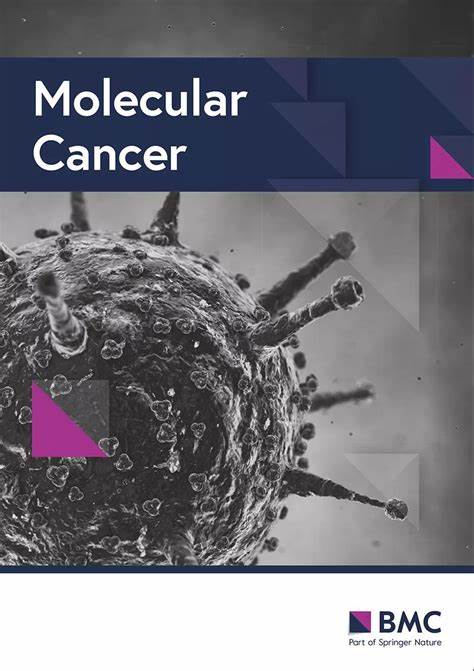ADAR1-high tumor-associated macrophages induce drug resistance and are therapeutic targets in colorectal cancer
IF 27.7
1区 医学
Q1 BIOCHEMISTRY & MOLECULAR BIOLOGY
引用次数: 0
Abstract
Colorectal cancer (CRC) is considered the third most common type of cancer worldwide. Tumor-associated macrophages (TAMs) have been shown to promote drug resistance. Adenosine-to-inosine RNA-editing, as regulated by adenosine deaminase acting on RNA (ADAR), is a process that induces the posttranscriptional modification of critical oncogenes. The aim of this study is to determine whether the signals from cancer cells would induce RNA-editing in macrophages. The effects of RNA-editing on phenotypes in macrophages were analyzed using clinical samples and in vitro and in vivo models. The intensity of the RNA-editing enzyme ADAR1 (Adenosine deaminase acting on RNA 1) in cancer and mononuclear cells indicated a strong positive correlation between the nucleus and cytoplasm. The ADAR1-positive mononuclear cells were positive for CD68 and CD163, a marker for M2 macrophages. Cancer cells transport pro-inflammatory cytokines or ADAR1 protein directly to macrophages via the exosomes, promoting RNA-editing in AZIN1 (Antizyme Inhibitor 1) and GLI1 (Glioma-Associated Oncogene Homolog 1) and resulting in M2 macrophage polarization. GLI1 RNA-editing in the macrophages induced by cancer cells promotes the secretion of SPP1, which is supplied to the cancer cells. This activates the NFκB pathway in cancer cells, promoting oxaliplatin resistance. When the JAK inhibitors were administered, oncogenic RNA-editing in the macrophages was suppressed. This altered the macrophage polarization from M2 to M1 and decreased oxaliplatin resistance in cancer cells. This study revealed that ADAR1-high TAMs are crucial in regulating drug resistance in CRC and that targeting ADAR1 in TAMs could be a promising treatment approach for overcoming drug resistance in CRC.高adar1肿瘤相关巨噬细胞诱导耐药,是结直肠癌的治疗靶点
结直肠癌(CRC)被认为是全球第三大最常见的癌症类型。肿瘤相关巨噬细胞(tam)已被证明可促进耐药。腺苷-肌苷RNA编辑,由作用于RNA的腺苷脱氨酶(ADAR)调控,是一个诱导关键癌基因转录后修饰的过程。本研究的目的是确定来自癌细胞的信号是否会诱导巨噬细胞的rna编辑。通过临床样本和体外、体内模型分析rna编辑对巨噬细胞表型的影响。cancer和单核细胞中RNA编辑酶ADAR1 (Adenosine deaminase acting on RNA 1)的强度表明细胞核和细胞质之间存在很强的正相关。adar1阳性的单核细胞CD68和CD163 (M2巨噬细胞的标志物)阳性。癌细胞通过外泌体将促炎细胞因子或ADAR1蛋白直接转运到巨噬细胞,促进AZIN1 (Antizyme Inhibitor 1)和GLI1 (Glioma-Associated癌基因同源物1)的rna编辑,导致M2巨噬细胞极化。癌细胞诱导的巨噬细胞中GLI1 rna的编辑促进了SPP1的分泌,SPP1供给癌细胞。这激活癌细胞中的NFκB通路,促进奥沙利铂耐药性。当给予JAK抑制剂时,巨噬细胞中的致癌rna编辑被抑制。这改变了巨噬细胞从M2到M1的极化,降低了癌细胞对奥沙利铂的耐药性。本研究表明,高ADAR1的tam在调节结直肠癌耐药中起着至关重要的作用,在tam中靶向ADAR1可能是克服结直肠癌耐药的一种有希望的治疗方法。
本文章由计算机程序翻译,如有差异,请以英文原文为准。
求助全文
约1分钟内获得全文
求助全文
来源期刊

Molecular Cancer
医学-生化与分子生物学
CiteScore
54.90
自引率
2.70%
发文量
224
审稿时长
2 months
期刊介绍:
Molecular Cancer is a platform that encourages the exchange of ideas and discoveries in the field of cancer research, particularly focusing on the molecular aspects. Our goal is to facilitate discussions and provide insights into various areas of cancer and related biomedical science. We welcome articles from basic, translational, and clinical research that contribute to the advancement of understanding, prevention, diagnosis, and treatment of cancer.
The scope of topics covered in Molecular Cancer is diverse and inclusive. These include, but are not limited to, cell and tumor biology, angiogenesis, utilizing animal models, understanding metastasis, exploring cancer antigens and the immune response, investigating cellular signaling and molecular biology, examining epidemiology, genetic and molecular profiling of cancer, identifying molecular targets, studying cancer stem cells, exploring DNA damage and repair mechanisms, analyzing cell cycle regulation, investigating apoptosis, exploring molecular virology, and evaluating vaccine and antibody-based cancer therapies.
Molecular Cancer serves as an important platform for sharing exciting discoveries in cancer-related research. It offers an unparalleled opportunity to communicate information to both specialists and the general public. The online presence of Molecular Cancer enables immediate publication of accepted articles and facilitates the presentation of large datasets and supplementary information. This ensures that new research is efficiently and rapidly disseminated to the scientific community.
 求助内容:
求助内容: 应助结果提醒方式:
应助结果提醒方式:


